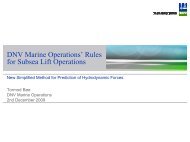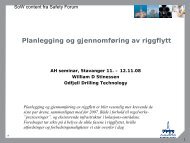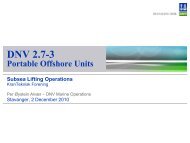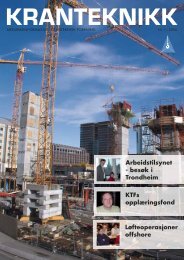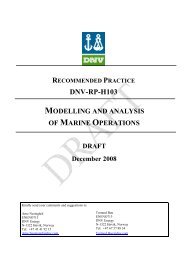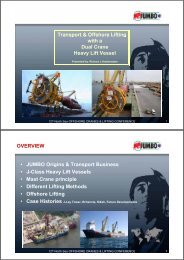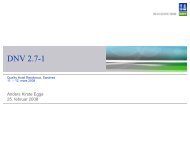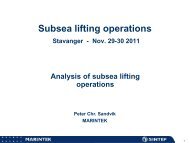NORSOK R-002 Rev. 2
NORSOK R-002 Rev. 2
NORSOK R-002 Rev. 2
Create successful ePaper yourself
Turn your PDF publications into a flip-book with our unique Google optimized e-Paper software.
<strong>NORSOK</strong> R-<strong>002</strong> Edition 2<br />
Lifting equipment Annex G and K<br />
September 2012<br />
Classification: Internal 2012-02-20
Annex G (Normative) Cranes<br />
2<br />
Classification: Internal 2012-02-20
Annex G – Cranes - Requirement philosophy<br />
Additional requirements due to the<br />
“offshore risks”<br />
EN Standards for cranes<br />
<strong>NORSOK</strong> R-<strong>002</strong><br />
High risk application?<br />
Annex K<br />
3<br />
Classification: Internal 2012-02-20
WG11<br />
Mobile cranes<br />
WG12<br />
Tower cranes<br />
WG13<br />
Slewing jib cranes<br />
WG14<br />
Bridge and gantry<br />
WG15<br />
Offshore cranes<br />
WG16<br />
Floating cranes<br />
WG17<br />
Winches and hoists<br />
WG18<br />
Loader cranes<br />
WG19<br />
Cable cranes<br />
WG20<br />
Hand operated cranes<br />
WG21<br />
Non fixed attachments<br />
WG22<br />
Manipulating devices<br />
CEN/TC147 Crane safety<br />
TC147<br />
WG1 Terminology and harmonisation<br />
WG2 Crane Safety – Design - General<br />
WG3 Crane Safety – Design – Requirements for equipment<br />
WG4 Crane Safety – Requirements for health and safety<br />
WG5 Crane Safety – Requirements for inspection and safe use<br />
4<br />
Workshop on<br />
06<br />
December<br />
2012
Annex G Cranes - types<br />
5<br />
Classification: Internal 2012-02-20
G.3 Design criteria<br />
Design loads, ref. 5.7<br />
Principle for proof of competence:<br />
EN13001-1<br />
Load combinations: DNV SC 2.22<br />
Loads, load actions, load combinations and load effects: EN13001-2<br />
Fatigue:<br />
DNV RP-C203<br />
Mechanisms: FEM 1.001<br />
EN13135-2<br />
Operating temperatures<br />
T 0min = -20°C unless otherwise agreed<br />
6<br />
Classification: Internal 2012-02-20
G.3 Design criteria – inclination angles<br />
Cranes used onshore<br />
Minimum inclination from the horizontal in all directions: 1°<br />
Cranes used offshore<br />
7<br />
Classification: Internal 2012-02-20
G.3 Horizontal loads due to operational motions<br />
G.3.4 Horizontal loads due to operational motions<br />
For cranes mounted on floating units or vessels, horizontal loads due to<br />
operational motions are<br />
a) inertia forces due to acceleration or deceleration of horizontal<br />
motions,<br />
b) centrifugal forces,<br />
c) forces transverse to rail resulting from reeling and skew motion,<br />
d) buffer loads.<br />
The horizontal loads shall be taken into account in the design loads.<br />
8<br />
Classification: Internal 2012-02-20
G.3 Wind loads<br />
Cranes located outdoor in exposed areas<br />
shall be designed for loads due to wind in<br />
accordance with EN 13001-2. The wind<br />
velocities shall unless otherwise agreed<br />
between the buyer and the manufacturer,<br />
be taken as follows:<br />
a) 25 m/s for in service;<br />
b) 63 m/s for out of service.<br />
NOTE These wind velocities are to be<br />
understood as a 3 s gust wind. Wind<br />
velocities are often given as 10 min mean<br />
wind velocity. A 3 s gust wind velocity of 25<br />
m/s will correspond to about 17 m/s 10 min<br />
mean wind velocity, but may depend on<br />
surrounding structures on the platform.<br />
9<br />
Classification: Internal 2012-02-20
G.3.7 Lifting of persons<br />
For the lifting of persons, the methods of decreasing the probability of failure in<br />
accordance with EN 13135-2, 5.12.3.2, shall be applied.<br />
The risk coefficient γn for cranes designed for the lifting of persons, shall be<br />
minimum 1,5.<br />
The required performance level for cranes lifting personnel shall be d in<br />
accordance with ISO 13849-1.<br />
See also item 5.9 and annex K High risk applications<br />
G.3.8 Cranes for temporary use offshore<br />
Powered cranes intended for temporary use on an offshore installation shall<br />
also comply with <strong>NORSOK</strong> Z-015.<br />
10<br />
Classification: Internal 2012-02-20
G.4 Cranes with emergency operation system (EOS)<br />
• Initiated and controlled from the control station<br />
• Secondary independent power supply<br />
• Secondary independent controls<br />
• Main functions for moving the load – one at the time<br />
• Simple to operate without undue delay (1 min)<br />
• Min.10% of required speeds<br />
• Emergency stop<br />
11<br />
Classification: Internal 2012-02-20
Mobile cranes (Group G1)<br />
Use:<br />
EN13000:2010 + G.1 + General part of<br />
<strong>NORSOK</strong> R-<strong>002</strong><br />
(Additional requirements if used for the lifting of<br />
persons and high risk applications)<br />
12<br />
Classification: Internal 2012-02-20
Tower cranes (Group G2)<br />
Use:<br />
EN14439:2006+A2:2009 + G.1 + General<br />
part of <strong>NORSOK</strong> R-<strong>002</strong><br />
(Additional requirements if used for the lifting of<br />
persons and high risk applications)<br />
13<br />
Classification: Internal 2012-02-20
Slewing Jib cranes<br />
(Group G3)<br />
Use:<br />
EN14985:2012 + G.1 + General part of<br />
<strong>NORSOK</strong> R-<strong>002</strong><br />
(Additional requirements if used for the lifting of<br />
persons and high risk applications)<br />
14<br />
Classification: Internal 2012-02-20
Bridge and gantry cranes<br />
(Group G4)<br />
Use:<br />
EN15011:2012 + G.1 + General part of<br />
<strong>NORSOK</strong> R-<strong>002</strong><br />
(Additional requirements if used for the lifting of<br />
persons and high risk applications)<br />
15<br />
Classification: Internal 2012-02-20
Offshore cranes (Group G5)<br />
Use:<br />
EN13852-1 + G.1-G.6 + General<br />
part of <strong>NORSOK</strong><br />
R-<strong>002</strong><br />
Size, capasity, no. off, location etc:<br />
•Compatible with Annex B (Material handling and offshore crane study)<br />
•Capable of offboard lifting in Hs=6m at 25m outreach<br />
•Capable of offboard lifting of 15 tonnes at Hs=0 at 32m from the side of the<br />
installation<br />
•Reflect the need of redundancy and ensure optimal working conditions<br />
•Unobstructed sight and avoid blind zones<br />
16<br />
Classification: Internal 2012-02-20
Offshore cranes (Group G5), continued<br />
Some supplementary requirements:<br />
•Access<br />
•View from the control station<br />
•Outfitting of the control station<br />
•Wind speed indicator<br />
•Warning horn<br />
•Rigging detection<br />
•Location of MOPS device to the left<br />
•Location of Em.stop device to the right<br />
•AOPS simulation and test facility<br />
•Anti collision protection (if required)<br />
17<br />
Classification: Internal 2012-02-20
Offshore cranes (Group G5), continued<br />
Hook velocities:<br />
V<br />
i<br />
<br />
K<br />
i<br />
<br />
<br />
V<br />
2<br />
D<br />
V<br />
2<br />
C<br />
<br />
V H<br />
V R<br />
V L<br />
With and without loads<br />
18<br />
Classification: Internal 2012-02-20
Floating cranes (Group G6)<br />
Use:<br />
EN13852-2 + G.1-G.6 + General part<br />
of <strong>NORSOK</strong> R-<strong>002</strong><br />
(Additional requirements if used for the lifting of<br />
persons, subsea lifting and high risk<br />
applications)<br />
19<br />
Classification: Internal 2012-02-20
Cranes for subsea operation<br />
(Group G5, G6, G7 etc.)<br />
Additional requirements to address:<br />
•Sea water penetration and corrosion<br />
•Load hoist drum<br />
•Rated capacity indicator<br />
•Rope tensioning system<br />
•Heave compensation system<br />
•Performance level<br />
•Subsea operation mode<br />
•AOPS<br />
•Instruction for use<br />
20<br />
Classification: Internal 2012-02-20
Power driven winches and<br />
hoists (Group G10)<br />
Winches:<br />
EN14492-1 + G.1-G.6 + General part of <strong>NORSOK</strong> R-<strong>002</strong><br />
Hoists:<br />
EN14492-2 + G.1-G.6 + General part of <strong>NORSOK</strong> R-<strong>002</strong><br />
(Additional requirements if used for the lifting of<br />
persons, subsea lifting and high risk applications)<br />
21<br />
Classification: Internal 2012-02-20
Loader cranes (Group G8)<br />
Use:<br />
EN12999 + G.3 + General part of <strong>NORSOK</strong> R-<strong>002</strong><br />
(Additional requirements if used for the lifting of<br />
persons and high risk applications)<br />
22<br />
Classification: Internal 2012-02-20
Hand powered hoists and<br />
trolleys (Group G10)<br />
Use:<br />
EN13157 + G.3 + General part of <strong>NORSOK</strong> R-<strong>002</strong><br />
(Additional requirements if used for high risk<br />
applications)<br />
23<br />
Classification: Internal 2012-02-20
Other cranes (G20)<br />
The design criteria stated in G.3 apply.<br />
• Mobile elevating work platforms shall be in<br />
accordance with EN 280.<br />
• Mast climbing platforms shall be in accordance with<br />
EN 1495.<br />
• Suspended access equipment shall be in<br />
accordance with EN 1808.<br />
• Lifting tables shall be in accordance with EN 1570.<br />
For cranes used in drilling operations, reference is also<br />
made to the requirements in Annex D.<br />
NOTE Powered slewing cranes mounted in a fixed installation (often<br />
referred to as “G20 cranes” in the industry) are covered by Group<br />
G3.<br />
24<br />
Classification: Internal 2012-02-20
Annex K High risk appliances (Informative)<br />
25<br />
Classification: Internal 2012-02-20
Why high risk applications?<br />
26<br />
Classification: Internal 2012-02-01
Why high risk applications?<br />
Condensate leakage at Kollsnes 19.05.2009<br />
A crane that was in operation in the exposed area prior to the leakage<br />
represented a potential ignition source.<br />
27<br />
Classification: Internal 2012-02-01
Why high risk applications?<br />
Lifeboat launching arrangement incident<br />
During testing, a 85mm Ø solid piston rod of a hydraulic cylinder failed,<br />
lifeboat with crew of 5 saved to fall to sea by second cylinder.<br />
28<br />
Classification: Internal 2012-02-01
Luffing winch gear Statoil GFA Offshore crane<br />
29<br />
Classification: Internal 2012-02-01
Boom failure during lifting of persons
What are high risk applications?<br />
Hamonised standards adress technical solutions for the vast majority of cranes. Cranes are sometimes used in<br />
applications which represent exeptional risks.<br />
The exeptional risks can be assosiated with major accidents, where the crane or the lifting operation might cause<br />
seroius harm beyond the damage of the crane or the load itself.<br />
Such unacceptable consequences need to be avoided regardless of the probability.<br />
31<br />
Classification: Internal 2012-02-01
High risk applications - typical<br />
Some cranes have higher risk than others:<br />
− Lifting of or over persons<br />
− Lifting in nuclear plants<br />
− Lifting of explosives and radioactive materials<br />
− Lifting of hot molten metal<br />
− Operations in explosive atmospheres<br />
− Lifting over explosives, flammable and dangerous chemicals<br />
− Lifting of giant constructions<br />
32<br />
Classification: Internal 2012-02-01
Consequence<br />
Risk matrix<br />
High risk<br />
applications<br />
Normal<br />
applications<br />
Probability<br />
The potential consequences of high risk applications<br />
need to be avoided/reduced regardless of the probability<br />
33<br />
Classification: Internal 2012-02-01
Strategy for mitigation of high risks<br />
Operational<br />
measures (M)<br />
Technological<br />
measures (T)<br />
Organisational<br />
measures (O)<br />
Probability<br />
reduction<br />
Competence,<br />
training and<br />
procedures,etc.<br />
Fail-safe, redundant<br />
and improved<br />
technical solutions<br />
combined with<br />
monitoring, etc.<br />
Resources and<br />
capabilities, etc.<br />
Consequence<br />
reduction<br />
Emergency<br />
preparedness<br />
plans,etc.<br />
Strength<br />
proportion,<br />
emergency<br />
systems,<br />
instructions for<br />
use, etc.<br />
Strategies for<br />
major accidents<br />
34<br />
Classification: Internal 2012-02-01
K.2 Principle of high risk reduction<br />
The prioritized sequence of reducing high risks:<br />
1. Inherent safe design, see K.3<br />
2. Protective measures, see K.4<br />
3. Information for use, see K.5<br />
35<br />
Classification: Internal 2012-02-20
K.3 Inherent safe design<br />
• Inherent safe design shall ensure that a component or element which are needed<br />
to suspend or move the load or main parts e.g. the boom, of the lifting appliance,<br />
does not cause the load or the part of the lifting appliance to fall or move<br />
unexpectedly in case of a single failure.<br />
• All load bearing structure, mechanisms and suspensions for high risk applications<br />
shall either be redundant (duplicated) or be designed with an increased risk<br />
coefficient, γn .<br />
• Redundancy by duplicating components shall be the preferred measure, except for<br />
structure such as foundations, pedestals, superstructure, booms and mechanisms<br />
where duplication is normally not feasible or will create other significant hazards of<br />
high risks.
Table K.2 Examples of duplication related to high risk class<br />
Example of duplication High risk class I High risk class II<br />
Backup brake with independent load path on single<br />
winch<br />
Single hydraulic cylinders with mechanical lock<br />
Single winch with dual load suspension system<br />
(wireropes or chains)<br />
X<br />
X<br />
X<br />
Dual winch with dual suspension (Single failure proof) X X<br />
Dual hydraulic cylinders with independent load holding<br />
valves (Single failure proof)<br />
X<br />
X
Table K.3 Risk coefficient for high risk classes<br />
γn<br />
High risk class I Min. 1,5<br />
High risk class II 2<br />
γn is the risk coefissient as defined in EN13001-2.
Table K.4 Required performance level (EN ISO 13849-1)<br />
Performance level PLr<br />
High risk class I<br />
High risk class II<br />
d or e<br />
e<br />
PLr = d, Average probability of dangerous failure per hour >= 10 -7 to < 10 -6<br />
PLr = e, Average probability of dangerous failure per hour >= 10 -8 to < 10 -7
Other protective measures and information for use<br />
• Back-up motion limiters of diverted technology<br />
• Crane level limiter for mobile cranes, loader cranes etc.<br />
• Automatic rigging detection system<br />
• Emergency operation system (EOS)<br />
• Competence<br />
• Operation, inspection and maitenance<br />
• Specific operational risk analysis<br />
• Planning of lifting routes<br />
• Operational limitations<br />
• Protection of equipment<br />
• Lifting accessories
High Risk Application summary<br />
Safety related parts<br />
of control system:<br />
Performance level<br />
PLr = d or e<br />
(single failure proof<br />
with monitoring)<br />
acc. to ISO 13849-1<br />
Instruction for<br />
use and user<br />
requirements:<br />
Additional<br />
requirements<br />
Installation structure<br />
Crane<br />
foundation<br />
Main<br />
structure<br />
Boom<br />
Load<br />
Structure and mechanisms:<br />
Increased capacity due to strength<br />
proportion and a risk coeficcient<br />
Increased capacity due to a risk<br />
coefficient<br />
Redundancy by dual components and<br />
load equalization<br />
Increased capacity due to a risk<br />
coefficient<br />
Redundancy by dual components and<br />
load equalization<br />
Dual suspension points<br />
41<br />
Classification: Internal 2012-02-01
Presentation title<br />
Presenters name<br />
Presenters title<br />
E-mail address ……@statoil.com<br />
Tel: +4700000000<br />
www.statoil.com<br />
42<br />
Classification: Internal 2012-02-20



